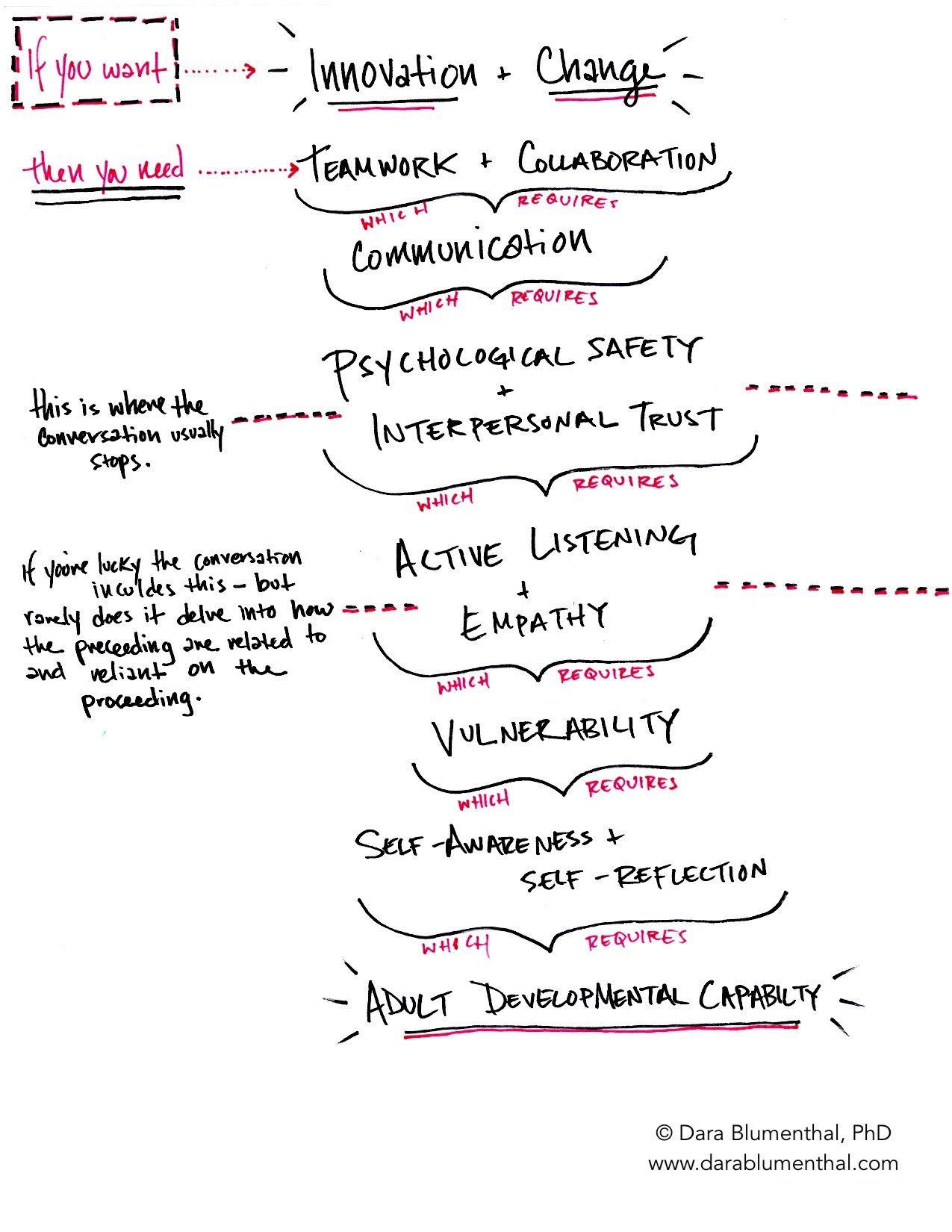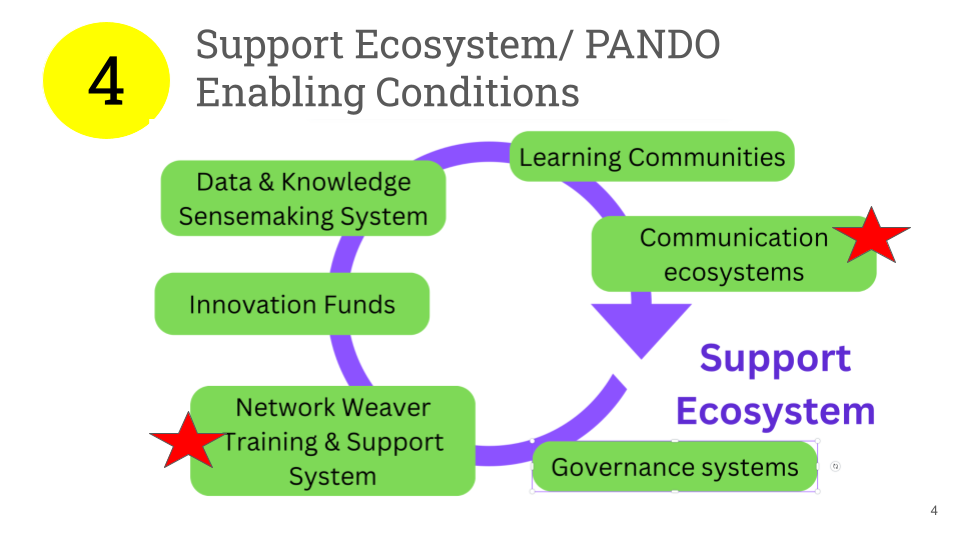The standard playbook for developing high-performing teams is wrong. Its laser-focus on productivity and efficiency can actually impede performance when things get ambiguous and complex. Here’s the irony: our most pressing problems are inherently ambiguous and complex, but as they become more urgent, we return to that same dysfunctional playbook, doubling down on business as usual. We track easy to measure (but often meaningless) outcomes, install beer taps and Foosball tables in the break room, dole out rewards and recognition, budget our time to the minute, and spend hours in pointless project management meetings. Ultimately, none of these do much good, and many stifle the creativity and curiosity needed to understand and solve the hard problems we’re facing.
As it turns out, teams that perform well in complex contexts already know this. They don’t obsess over how to be productive or efficient. Instead, they focus on something far more important: team health.
A healthy team grows and thrives when the conditions are right, in the same way a seed grows into a healthy plant in fertile soil and suitable light. The metaphor might seem cheesy, but we chose it intentionally, because the metaphor of a team as a well-oiled machine is what got us into this mess in the first place. A team can’t be engineered to perfection, because it’s made of people, not parts. Parts are exactly as they need to be, but people develop throughout their whole lives, never reaching a finished form. The garden, as a developing system, provides a better way to think of a team.
In the rest of this article, we’ll explore five of the fundamental conditions for growing a healthy team:
- Safety
- Learning
- Listening
- Purpose
- Autonomy

1. Safety
It’s easy to dismiss psychological safety as “fluff” that distracts us from the real work. But the opposite of safety is fear and anxiety, and there’s plenty of research showing how hard it is for people to be creative when they’re afraid. Team members can only do the hard work of being creative contributors and problem solvers when they feel safe. Healthy teams create judgement-free environments. Playful idea generation and experimentation become the norm. When new ideas are allowed to bubble up, flow freely, combine and evolve, they can lead to high-value solutions.
The benefits of a psychologically safe space don’t stop at “getting the job done.” When team members feel safe together, they build trust and cultivate strong relationships. They feel and foster a sense of belonging. All of this allows the team to grow together and thrive in their work and even in their personal lives. Who doesn’t want that?
So, how do we get it? First, we have to keep in mind that safety emerges from a complex system. People and processes, mindsets and behaviors, and incentives and external pressures all interact in a dynamic balancing act. There are myriad ways to develop and maintain a system like this, so we can’t just hand you a standard recipe. But we can list some essential ingredients that must be part of the system for safety to emerge: Empathy, vulnerability, curiosity, growth mindset, trust, self-awareness, courage, and openness.
Get the Conversation Started
A good starting place for developing psychological safety with your team is to simply open up a discussion about it. A safe environment is co-created, so the whole team needs to participate. If being open with each other is an issue for your team, engage a professional facilitator to ensure that the conversation is honest and generative. Ask questions like: Which individual and group mindsets and practices are helping to build safety? Which aren’t? What might you do to enhance safety and trust? What do you need to stop doing? Don’t stop at one conversation. You’re building a feedback loop that allows everyone on your team to learn from each other, make adjustments, and improve over time.
Of course, creating psychological safety doesn’t mean the work will be easy or challenges won’t arise. It does mean that you and your team will be prepared to weather any storm and to grow more connected and effective both during and after it.

2. Learning
Most learning doesn’t happen in a classroom or a formal training because we’re best at learning “in the wild.” For modern humans, that means our daily experiences–chatting with a friend over coffee, standing in line at the grocery store, scrolling through Twitter, cooking dinner, and so on. These spontaneous encounters are always educating us. Unfortunately, some experiences, like struggling to satisfy a perfectionist boss or being punished for taking a well-calculated risk, can sabotage our innate curiosity. When a team shares too many of these experiences, it’s members learn that growth is dangerous and they can even get stuck in the trap of “learning not to learn.” Once that happens, they can’t adapt, perform, or make an impact.
On the other hand, healthy teams activate growth by cultivating curiosity, which leads to deep, generative learning experiences. Curiosity is what allows us to thoroughly explore a situation, even if it’s uncomfortable, without jumping to an answer too quickly. When we get curious about our collective challenges, we can better manage the discomfort of the uncertainty, confusion, and frustration that come with them, which both moves us toward our purpose, and makes us stronger as a team. That’s why curiosity is on the list of must-have ingredients for psychological safety.
When we’re curious, we cultivate feedback loops that simultaneously promote individual and group learning, creating an upward spiral where people learn and become more skilled, and those skills open up new frontiers of learning, which further increase their skill level. Over time, as each team member learns and gets better, so does the team as a whole. How could you possibly develop a high-performing team without this dynamic?
Foster curiosity with team "retros"
If you’re beginning to organize your team around curiosity and learning, try scheduling regular team conversations that prompt reflection—like retrospectives where the team asks, “What’s been going well? What hasn't been working? What could we change? What low-stakes experiments could we do to determine if our changes actually improve things?”
P.S. NOTE, added 4 Feb 2022: As a remote team, we use and love Parabol for our retros. Open-source, clean, fun, and fast.
Once you think you know what needs to change, it’s time to experiment by making incremental shifts, building prototypes, or even role playing to test new ideas. If your changes fail to make things better, then get curious: reflect, learn from the failure, and keep iterating! On a healthy team, members can learn and grow every time they interact with one another, face a challenge, fail, or find success. As you and your team begin to learn and grow together, you’ll be able to adapt and iterate your way to creating real impact.

3. Listening
Communication is more than just transporting an idea from one brain to another. It’s a process that requires listening, perspective taking, and developing shared understanding. These are especially important when we’re working remotely, and when our work is in a complex, fast moving domain, both of which tend to compound misunderstandings and undermine alignment..
Listening is a key skill that healthy teams are especially careful to cultivate, and they practice it through dialogue. As opposed to discussion or debate, the purpose of dialogue is to work together to build a shared understanding, not to generate ideas, solve a problem, or make a decision. In dialogue, we have to flex our listening muscles because our aim is to really hear each participant’s perspective, figuring out how they fit together and synthesizing them into a larger whole.
Invite an inquiry session
Here’s a way to spark this kind of dialogue on your team: invite everyone to help you understand how something works (maybe a team process or customer journey). Schedule a 60-minute conversation that’s solely dedicated to getting everyone’s perspective on how that thing works. Give your team a few key instructions:
- This is a judgement free space where everyone can share their thoughts.
- We’re going to stay on topic and bring each other back to the key question if we stray too far.
- It’s important that everyone stays tuned into the conversation–we can only listen well when our attention is focused on what others are saying.
This is an opportunity to lead by example, and model good listening. During the dialogue, make sure that everyone has a chance to offer their insights or ask questions. In the last 10 minutes, have a team member sum up what they heard, then have others add to or rephrase the synthesis.
Dialogue can be extremely clarifying, and you might discover that it’s an excellent catalyst for idea generation! But what’s really happening is that your team is learning to listen carefully to one another, to take each other's perspectives, and to develop shared understanding. That’s collaborative communication!

4. Purpose
On a healthy team, every member knows why they’re doing what they’re doing. Not just, “I know why this task needs to get done,” but also the bigger “why” that’s driving the whole project. Each person can connect a through-line from their daily work to that purpose. The reason for doing the work should deeply resonate with every member of the team, because a strong sense of purpose keeps everyone moving in the same direction, toward a common goal. Purpose serves not only as a point to aim for, but as a team boundary. Knowing when to say no to a project or task can be super challenging, but when you have a clear purpose, you can easily decide whether a new idea is aligned or not. A well-articulated purpose will help potential team members find and participate with teams where they really belong.
Seeking shared purpose, done well, will involve an exploration of what matters most to people, so make room for strong feelings! Purpose so often stems from the heartbreaks of society we want to repair, legacies we want to leave our children, and the people we hope to become. It's not a cold north star, far from our hearts.
Does your team have purpose alignment?
Want to know if your team has a clear purpose? Here’s a quick exercise that will take between 20 and 60 minutes: Ask each of your team members to jot down what they think the team’s purpose is on a sticky note (physical or digital). After about five minutes, have everyone post their notes at the same time, then read them aloud to the group. If you’ve all written basically the same thing, congrats—you have a shared sense of purpose! If there’s quite a bit of variation in the statements, that’s okay. Spend some time trying to understand why folks are seeing things differently (remember dialogue?), and begin to synthesize the statements into a single, clear articulation of your purpose. If there’s strong disagreement or you’ve surpassed your 60 minute time-box, set a time to come back to the conversation later. Don’t be surprised if it takes a few sessions, quite a bit of dialogue, and a lot of collaborative editing to illuminate and articulate your team’s purpose. We assure you, it’s worth the effort!

5. Autonomy
In a team context, the word “autonomy” might evoke a “do whatever I want, whenever I want” kind of entitlement: So what if we have that big presentation to prepare for? I’m tired and don’t feel like working today. Everyone else can take care of this one, and I’ll help next time. But it’s quite the opposite. Autonomy is about having the trust and authority to make important decisions about how we fulfill our responsibilities and accomplish our goals. When we have creative freedom in our area of expertise, we not only find flow and do excellent work; it also gives us a sense of ownership and motivates us to show up completely.
So how does autonomy play out on a team?
On a healthy team, each member understands their own roles and everyone else's. They have skill and freedom to fulfill their responsibilities and trust that their teammates do as well. And finally, they can all see how their work fits into the larger picture. So autonomy in a team context means balancing your needs with the needs of others and of the team as a whole. It means taking responsibility for the decision making and behaviors related to your work, and it’s something that every member on a healthy team accepts for themselves and gives to others.
Role clarity is also essential. Autonomy doesn’t work without it because you can’t get oriented and make decisions about your own work unless you understand how others on the team depend on you. Role clarity decreases the need for constant updates, prevents redundant work from happening, and keeps autonomous work harmonious. Before autonomy, you need to establish role clarity.
Role clarity increases autonomy
Here’s an 60-90 minute exercise that can help your team members to clarify their roles:
First, give everyone about five minutes to write down their roles and responsibilities on sticky notes (make sure there’s only one role or responsibility per note). You may need to move the stickies around, so have everyone add a name or initial to each of their notes. Then, ask everyone to post their notes on a whiteboard, and, as a group, use a marker to draw connections between roles. Now stand back and observe how everyone’s roles interact, then discuss them and make changes and corrections wherever they’re needed. Here are some clarifying questions you might want to ask:
- What roles are people playing that haven’t been captured?
- Does everyone agree on what each person’s roles are?
- Are the roles, as represented, working for each team member? For the team as a whole?
This exercise is meant to guide a conversation by revealing differences in individual mental models. When everyone is satisfied with the model of roles and how they’re connected, then you’ve successfully completed the exercise. If you can’t finish in one session, don’t worry! Knowing that your team needs to get aligned around roles is a step in the right direction.
It's All Connected
You’ve probably noticed that the five conditions for team health are all connected in ways that can create “virtuous cycles,” which make things better over time. For example, curiosity makes team members better listeners, which increases the team’s sense of safety, allowing them to be even more curious.
When team members are safe, can learn and adapt, share a common purpose, understand and support each other, and stay accountable to one another, you’ve got a healthy team. But a team only becomes high-performing as they create and maintain virtuous cycles that continuously improve health, allowing everyone to grow.
Okay, now what? The nice thing is that you can create these virtuous cycles by focusing on any of these aspects of team health. Think about where your team is at now. What does it need most? What is it ready to learn? Then go from there.
As with so many things worth doing, developing a healthy team is a journey—it’s never static, and you’ve never arrived. The path is zig-zaggy and full of obstacles and surprises. But just like growing a garden, the results can be both practical and beautiful.
We're designing Socialroots to encourage and support team health. Want to find out how it works? Sign up for early access here.
Additional Resources
- The Fearless Organization, Amy Edmondson
- Dara Blumenthal, Generative Team Design:

- Amy Edmondson on the importance of people in power "being wrong often" and learning out loud:
- Adrienne Maree Brown: In this short excerpt from an interview, Adrienne Maree Brown talks about how aligned purpose can emerge from those heartbreaks, from shared experience of hardship, and help catalyze action.
- Listening gets easier when you recognize the mode someone is speaking from. This short article from the organizational design consultancy, August, gives a good overview of common teamwork modes.





